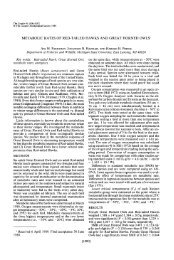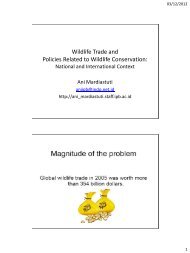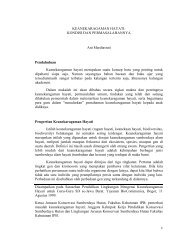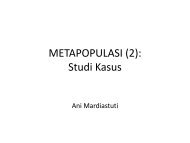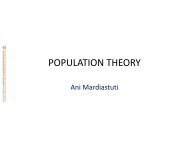Home range, diet and behaviour of the Tonkean Macaque (Macaca ...
Home range, diet and behaviour of the Tonkean Macaque (Macaca ...
Home range, diet and behaviour of the Tonkean Macaque (Macaca ...
Create successful ePaper yourself
Turn your PDF publications into a flip-book with our unique Google optimized e-Paper software.
<strong>Home</strong> Range, Diet <strong>and</strong> Behaviour <strong>of</strong> <strong>the</strong> <strong>Tonkean</strong><br />
<strong>Macaque</strong> (<strong>Macaca</strong> tonkeana) in Lore Lindu<br />
National Park, Sulawesi<br />
Anna R. Pombo, Matthias Waltert, S. Supraptini Mansjoer, Ani Mardiastuti &<br />
Michael Mühlenberg<br />
Introduction<br />
According to Fooden (1969, 1980) <strong>the</strong>re are 19 species in <strong>the</strong> genus <strong>Macaca</strong>, <strong>of</strong><br />
which seven occur endemically on Sulawesi, an area covering less than 2% <strong>of</strong> <strong>the</strong><br />
total generic <strong>range</strong> (Albrecht 1978 cited in Bynum et al. 1997). Although <strong>the</strong>re are<br />
already several field studies on <strong>Macaca</strong> nigra, <strong>Macaca</strong> nigrescen, <strong>and</strong> <strong>Macaca</strong><br />
maura (MacKinnon 1980, Sugardjito et al. 1989, Supriatna 1991, Kohlhaas 1993,<br />
Kinnaird <strong>and</strong> O’Brien 1995, 1996, Reed et al. 1997, Rosenbaum et al. 1998, Okamoto<br />
<strong>and</strong> Matsumura 2002), only little has been done on <strong>the</strong> <strong>behaviour</strong> <strong>and</strong> ecology<br />
<strong>of</strong> <strong>the</strong> <strong>Tonkean</strong> macaque <strong>Macaca</strong> tonkeana. The <strong>Tonkean</strong> macaque (<strong>Macaca</strong><br />
tonkeana) is a Central Sulawesi endemic <strong>and</strong> considered at lower risk/near threatened<br />
(Lr/nt) by IUCN categories (Hilton-Taylor 2000). Sulawesi <strong>Macaque</strong>s are<br />
found in lowl<strong>and</strong> <strong>and</strong> hill forests but only uncommon at elevations above 1500 m<br />
(Sarasin & Sarasin 1905, cited in Whitten, 1987). For <strong>Macaca</strong> tonkeana, <strong>the</strong> primary<br />
conservation issue at this time appears to be <strong>the</strong> ability <strong>of</strong> populations to persist<br />
in highl<strong>and</strong> protected areas, since habitat encroachment, hunting <strong>and</strong> eradication<br />
as crop raiders appear to pose problems at moderate elevations (Bynum et al.<br />
1999). The Lore Lindu National Park in Central Sulawesi is located in <strong>the</strong> centre<br />
<strong>of</strong> <strong>the</strong> species' <strong>range</strong> <strong>and</strong> is comprised <strong>of</strong> generally mountainous terrain with over<br />
90% <strong>of</strong> <strong>the</strong> park area located above 1000 m (Wirawan 1981).<br />
In this paper we present data from this area on <strong>the</strong> species’ home <strong>range</strong>, <strong>diet</strong><br />
<strong>and</strong> <strong>behaviour</strong>. During four months <strong>of</strong> fieldwork at lower montane elevations, two<br />
neighbouring groups were studied, one being situated in flat but anthropogenically<br />
disturbed forest <strong>and</strong> one in hilly near-primary forest. The main objectives were to<br />
identify <strong>and</strong> describe (1) group size <strong>and</strong> composition, (2) <strong>diet</strong>, (3) home <strong>range</strong> <strong>and</strong><br />
daily path lengths, <strong>and</strong> (4) activity patterns.<br />
We assumed that habitat quality is positively correlated with group size <strong>and</strong><br />
that – since animal movement is energetically expensive – it is negatively related<br />
to daily path lengths <strong>and</strong> home <strong>range</strong> size. We also assumed that <strong>the</strong> proportion <strong>of</strong><br />
time that animals spend with different activities should be closely related to variability<br />
in resource abundance <strong>and</strong> hence habitat quality (Terborgh 1983; Robinson<br />
1986; Kinnaird 1990 in O’Brien <strong>and</strong> Kinnaird 1997).
314 Anna R. Pombo, Matthias Waltert, S. Supraptini Mansjoer, Ani Mardiastuti &<br />
Michael Mühlenberg<br />
Methods<br />
Study site<br />
This study was conducted in <strong>the</strong> Lore Lindu National Park (LLNP), Central Sulawesi<br />
[01 o 25’ S, 120 o 18’ E] (Fig. 1). The 229,000 ha comprising <strong>the</strong> Park <strong>range</strong><br />
from c. 200 to 2,610 m above sea level (Watling 1983). Annual precipitation lies<br />
between 2,500 <strong>and</strong> 3,500 mm (Wirawan 1981 in Watling 1983). A 120 ha study<br />
area near <strong>the</strong> village <strong>of</strong> Wuasa in <strong>the</strong> Napu valley was established ranging in elevation<br />
from 1000 to 1500 m a.s.l. The study area was made accessible by parallel<br />
trails at 100 m distance <strong>and</strong> all trails were marked at 50 m intervals. A map was<br />
drawn from <strong>the</strong> study area on which 0.25 ha blocks were delineated. The forested<br />
area was characterised mainly by two different vegetation types: (a) an almost flat<br />
area with a mosaic <strong>of</strong> disturbance regimes including secondary forest <strong>and</strong> mixed<br />
c<strong>of</strong>fee/cocoa gardens under natural forest tree cover <strong>and</strong> (b) a near-primary hilly<br />
area with steep slopes without gardening activities but frequent rattan collection<br />
<strong>and</strong> hunting. Annual cultures, mainly maize fields or beans dominated <strong>the</strong> farml<strong>and</strong><br />
bordering <strong>the</strong> forest.<br />
Lower<br />
montane<br />
forest<br />
N<br />
0 0.5 1 km<br />
FARMLAND<br />
HiILL AREA<br />
Lore Lindu<br />
National Park<br />
FLAT AREA<br />
INDONESIA<br />
SULAWESI<br />
Fig. 1. Location <strong>of</strong> Sulawesi, Lore Lindu National Park <strong>and</strong> habitats <strong>of</strong> <strong>the</strong> study area. The<br />
hilly area (pale grey) was covered by largely undisturbed forest while <strong>the</strong> flat area (darker<br />
grey) was moderately disturbed by farming <strong>and</strong> tree felling.<br />
Gerold, G., Fremerey, M., Guhardja, E. (eds.) L<strong>and</strong> Use, Nature Conservation <strong>and</strong> <strong>the</strong> Stability <strong>of</strong><br />
Rainforest Margins in Sou<strong>the</strong>ast Asia. Springer, Berlin, Heidelberg. 2004
<strong>Home</strong> Range, Diet <strong>and</strong> Behaviour <strong>of</strong> <strong>the</strong> <strong>Tonkean</strong> <strong>Macaque</strong> (<strong>Macaca</strong> tonkeana) in Lore<br />
Lindu National Park, Sulawesi 315<br />
Data collection<br />
During a preliminary survey, six separate macaque groups <strong>and</strong> two solitary individuals<br />
were located in or near <strong>the</strong> study area, <strong>the</strong> groups ranging from ca. 10 to<br />
25 individuals (x = 16 individuals). Two neighbouring groups that were located<br />
near <strong>the</strong> forest margin were selected for data collection. Both groups were habituated<br />
to human observers.<br />
After a habituation period <strong>of</strong> four weeks (November 2001), each group was followed<br />
for four months <strong>and</strong> 5 days per week from 06.00 to 18.00 hrs <strong>and</strong> accompanied<br />
for 20-30 min more if necessary to map previously unknown sleeping trees.<br />
Every 0.5 hr each group's location was determined by assigning <strong>the</strong> group centre<br />
to a 0.25 ha block being part <strong>of</strong> a 50x50 m grid system that was measured from <strong>the</strong><br />
ground. The daily path lengths for each group was also measured using this grid.<br />
Behavioural data were collected via scan samples (Altman, 1974; Martin <strong>and</strong><br />
Bateson 1986; Paterson 1992) on 3 days/week <strong>and</strong> ad libitum, <strong>and</strong> inter-group interactions<br />
were also recorded. Activities were recorded during a 10 min period at<br />
30 min interval. When feeding, food items were collected using samples <strong>of</strong> leaves<br />
<strong>and</strong> fruit <strong>and</strong> later identified at <strong>the</strong> Herbarium Celebensis in Palu. Four classes <strong>of</strong><br />
activities were recognised:<br />
• Moving: locomotion including walking, running, climbing <strong>and</strong> jumping<br />
• Feeding: reaching for, picking, manipulating, masticating, or placing food in<br />
mouth, as well as manipulating <strong>the</strong> contents <strong>of</strong> a cheek pouch.<br />
• Resting: body stationary, usually sitting or lying down.<br />
• Social: playing, grooming, sexual <strong>and</strong> aggressive <strong>behaviour</strong>.<br />
Results<br />
Group size <strong>and</strong> composition<br />
The two groups observed differed in size: <strong>the</strong> large group (group A) consisted <strong>of</strong><br />
25 <strong>and</strong> <strong>the</strong> small group (group B) <strong>of</strong> 14 individuals. The male-female ratio was<br />
1:1.2 for group A <strong>and</strong> 1:1.3 for group B. Both groups showed a complete sex <strong>and</strong><br />
age composition (Table 1) with two adult females being pregnant in group A. In<br />
this group, a new infant was born during <strong>the</strong> fieldwork after which three members<br />
left <strong>the</strong> group. Group A was composed <strong>of</strong> 44% adults, 44% juveniles, <strong>and</strong> 12% infants<br />
while group B was composed <strong>of</strong> 50% adults, 43% juveniles, <strong>and</strong> 7% infants.<br />
<strong>Home</strong> <strong>range</strong> <strong>and</strong> daily path lengths<br />
The two groups were observed for a total <strong>of</strong> 85 days. Fig. 3 shows that <strong>the</strong> home<br />
<strong>range</strong> <strong>of</strong> <strong>the</strong> larger group was almost completely within <strong>the</strong> level forest area that<br />
was disturbed by small forest gardens <strong>and</strong> secondary forest while <strong>the</strong> smaller
316 Anna R. Pombo, Matthias Waltert, S. Supraptini Mansjoer, Ani Mardiastuti &<br />
Michael Mühlenberg<br />
group’s home <strong>range</strong> was situated mainly within <strong>the</strong> hilly but undisturbed forest.<br />
The frequency <strong>of</strong> use <strong>of</strong> 0.25 ha quadrats varied from 1-30 scores per quadrate<br />
during <strong>the</strong> study. The home <strong>range</strong>s <strong>of</strong> both groups were overlapping slightly in <strong>the</strong><br />
transition between <strong>the</strong> flat <strong>and</strong> <strong>the</strong> hilly area. The sizes <strong>of</strong> <strong>the</strong> home <strong>range</strong>s estimated<br />
from measurements along <strong>the</strong> transect grid revealed that <strong>the</strong> home <strong>range</strong> <strong>of</strong><br />
<strong>the</strong> large group was smaller with 44.5 ha than <strong>the</strong> one <strong>of</strong> <strong>the</strong> small group which<br />
covered 99.1 ha. However, <strong>the</strong> horizontal projection <strong>of</strong> <strong>the</strong> home <strong>range</strong>s using <strong>the</strong><br />
GPS measurements did not reveal such a large difference in home <strong>range</strong> size between<br />
<strong>the</strong> groups indicating <strong>the</strong> extreme hillside character <strong>of</strong> <strong>the</strong> small group’s<br />
home <strong>range</strong> (Fig.2). The average path length <strong>of</strong> <strong>the</strong> large group was 707m<br />
(±249m) <strong>and</strong> was significantly higher with a mean <strong>of</strong> 1500m (±292) in <strong>the</strong> small<br />
group (Wilcoxon test, Z=-6.93, p
<strong>Home</strong> Range, Diet <strong>and</strong> Behaviour <strong>of</strong> <strong>the</strong> <strong>Tonkean</strong> <strong>Macaque</strong> (<strong>Macaca</strong> tonkeana) in Lore<br />
Lindu National Park, Sulawesi 317<br />
Hilly area<br />
Group B<br />
Flat area<br />
600 m<br />
Group A<br />
Fig. 2. Minimum convex polygons <strong>of</strong> home <strong>range</strong>s <strong>of</strong> two groups <strong>of</strong> <strong>Tonkean</strong> <strong>Macaque</strong>s, as<br />
well as forest border (dashed), delimitation <strong>of</strong> hilly area (dotted), <strong>and</strong> location <strong>of</strong> sleeping<br />
(squares) <strong>and</strong> feeding trees (circles).
318 Anna R. Pombo, Matthias Waltert, S. Supraptini Mansjoer, Ani Mardiastuti &<br />
Michael Mühlenberg<br />
Group A<br />
11%<br />
18%<br />
51%<br />
Resting<br />
Socialising<br />
Locomotion<br />
Foraging<br />
20%<br />
Group B<br />
21%<br />
28%<br />
Resting<br />
Socialising<br />
Locomotion<br />
Foraging<br />
35%<br />
16%<br />
Fig. 3. Activity budgets for two <strong>Macaca</strong> tonkeana groups at Lore Lindu National Park during<br />
41 days <strong>of</strong> scan sampling. Group A (6657 observations) consisted <strong>of</strong> 25 individuals<br />
while Group B (7380 observations) consisted <strong>of</strong> 14 individuals.<br />
Gerold, G., Fremerey, M., Guhardja, E. (eds.) L<strong>and</strong> Use, Nature Conservation <strong>and</strong> <strong>the</strong> Stability <strong>of</strong><br />
Rainforest Margins in Sou<strong>the</strong>ast Asia. Springer, Berlin, Heidelberg. 2004
<strong>Home</strong> Range, Diet <strong>and</strong> Behaviour <strong>of</strong> <strong>the</strong> <strong>Tonkean</strong> <strong>Macaque</strong> (<strong>Macaca</strong> tonkeana) in Lore<br />
Lindu National Park, Sulawesi 319<br />
Table 1. Age <strong>and</strong> sex composition <strong>of</strong> two groups <strong>of</strong> <strong>Tonkean</strong> macaques <strong>Macaca</strong> tonkeana<br />
at Lore Lindu National Park, Central Sulawesi<br />
Group Adult Juvenile Infant Total<br />
M F M F M F<br />
A 5 6 4 7 3 - 25<br />
B 3 4 4 2 - 1 14<br />
Table 2. List <strong>of</strong> plant species <strong>and</strong> plant parts consumed by <strong>Macaca</strong> tonkeana at Lore Lindu<br />
National Park, Central Sulawesi.<br />
No Local Name Scientific Name Family Parts consumed<br />
1 Mbalahapu (1) Ficus variegata Moraceae L Fr<br />
2 Pangarehea Elastostema sp. Urticaceae St<br />
3 Mbalahapu (2) Ficus sp. Moraceae L<br />
4 Weli-weli Photos sp. Araceae St<br />
5 Nuhu Ficus sp. Moraceae L Fr<br />
6 Pondo Pleomele angustifolia Liliaceae L<br />
7 Bangkakara (1) Cryptocarya sp. Lauraceae St<br />
8 Bangkakara (2) Litsea sp. Lauraceae Fr<br />
9 Tambekakau Eugenia sp. Myrtaceae L Fl Fr<br />
10 Nunu tea Ficus sp. Moraceae L Fr<br />
11 Tohiti Calamus sp. Palmaceae Fr St<br />
12 Aropi Antidesma tetr<strong>and</strong>um Euphorbiaceae Fr<br />
13 Tiro-tiro Elaeocarpus sp. Elaeocarpaceae Fr<br />
14 Betau Calophyllum sp. Guttiferae Fr<br />
15 Andolia Canangium odoratum Annonaceae L Fr<br />
16 Kaulele Rapanea sp. Myrsinaceae Fr<br />
17 Pepolo Bisc<strong>of</strong>fia javanica Euphorbiceae Fr<br />
18 Lekatu Duabanga mollucana Sonneratiaceae L<br />
19 Warani Semecarpus sp. Anacardiaceae L<br />
20 Tea uru Artocapus teijsmanii Moraceae Fr<br />
21 Wala - Leguminosae L<br />
22 Kumowatu Guiou sp. Sapindaceae L Fl<br />
23 Nunu Ficus caulocarpa Moraceae L Fr<br />
24 Nunu Manetetawena<br />
Ficus sp. Moraceae L Fr<br />
25 Taite Dysoxylum sp. Meliaceae L Fr<br />
26 Wale nunu Ficus sp. Moraceae Fr<br />
27 Pisang monyet Musa sp. - L Fr L<br />
28 Harao Areca vestiaria Arecaceae Fr<br />
29 Harao maeta Arenga sp. Arecaceae Fr<br />
30 Mangkulobi - - Fr<br />
Abbreviations: Fr - fruit, L - leaf, Fl – flower, St – stem
320 Anna R. Pombo, Matthias Waltert, S. Supraptini Mansjoer, Ani Mardiastuti &<br />
Michael Mühlenberg<br />
Table 2 (cont.)<br />
No Local Name Scientific Name Family Parts consumed<br />
31 Kolombio - - Fr<br />
32 Aren Arenga pinnata Arecaceae Fr<br />
33 Lebanu Nauclea cyrtopoda Rubiaceae L<br />
34 Pala hutan Knema cinerea Myristicaceae Fr<br />
35 - Memecylon gibbosum Melastomataceae L Fr<br />
36 Pangi Pangium edule Flacourtiaceae Fr<br />
37 Kedondong hutan<br />
Spondia pinnata Anacardiaceae L Fr<br />
38 Anggrek - Orchidaceae Fl L<br />
39 Pondang P<strong>and</strong>anus sp. P<strong>and</strong>anaceae L<br />
40 Manggis hutan Garcinia sp. Clusiaceae Fl Fr<br />
(1)<br />
41 Manggis hutan Garcinia celebica Clusiaceae Fl Fr<br />
(2)<br />
42 Jamur Fungus -<br />
43 Liana (1) Alangium sp. Alangiaceae L Fr<br />
44 Kayu telor Alstonia ranvolfia Apocynaceae Fl Fr<br />
45 Kanari Canarium sp. Burceraceae Fr<br />
46 Jambu batu Psidium guajava Myrtaceae L Fr<br />
Discussion<br />
Group Size <strong>and</strong> Composition<br />
<strong>Macaque</strong>s (<strong>Macaca</strong> spp.) usually live in large, stable groups. <strong>Macaca</strong> nigra groups<br />
can contain 30-90 individuals, also <strong>Macaca</strong> fascicularis can reach 100 individuals<br />
(Kohlhaas 1993). In such large groups, <strong>the</strong> females usually outnumber males 4 to<br />
1, with <strong>the</strong> society being centred around female families, while males move away<br />
from <strong>the</strong>ir natal groups (Matsumura 1998). The groups <strong>of</strong> <strong>Macaca</strong> tonkeana we<br />
found were only between 10-30 individuals. With a male-female ratio <strong>of</strong> 1:1.2 to<br />
1:1.3 we expected our groups to have <strong>the</strong> capability to develop into bigger associations,<br />
but <strong>the</strong> fact that three group members left group A to form a new group suggests<br />
that larger groups might be less frequent in <strong>the</strong> species.<br />
Although much has been written about factors affecting group size in primates,<br />
this subject is still much in debate. Factors proposed to favour grouping in primates<br />
include protection from predators, defense <strong>of</strong> resources, improved foraging<br />
efficiency, <strong>and</strong> improved care giving opportunities (Dunbar 1988 in Kohlhaas<br />
1993). On Sulawesi, where predation must be relatively low <strong>and</strong> fruit availability<br />
– at least at lower altitudes - is usually high, larger groups than those observed by<br />
Gerold, G., Fremerey, M., Guhardja, E. (eds.) L<strong>and</strong> Use, Nature Conservation <strong>and</strong> <strong>the</strong> Stability <strong>of</strong><br />
Rainforest Margins in Sou<strong>the</strong>ast Asia. Springer, Berlin, Heidelberg. 2004
<strong>Home</strong> Range, Diet <strong>and</strong> Behaviour <strong>of</strong> <strong>the</strong> <strong>Tonkean</strong> <strong>Macaque</strong> (<strong>Macaca</strong> tonkeana) in Lore<br />
Lindu National Park, Sulawesi 321<br />
us can be expected. However, it is yet unclear whe<strong>the</strong>r fruit availability at submontane<br />
elevations <strong>of</strong> Lore Lindu is comparable to <strong>the</strong> lowl<strong>and</strong> areas so far studied<br />
within <strong>the</strong> <strong>range</strong>s <strong>of</strong> <strong>Macaca</strong> nigra.<br />
<strong>Home</strong> Range <strong>and</strong> Daily Path Length<br />
Since forest primates usually use food resources that are heterogeneously distributed<br />
in space <strong>and</strong> time, <strong>the</strong> search for food is a crucial part <strong>of</strong> <strong>the</strong>ir life, affecting<br />
also o<strong>the</strong>r <strong>behaviour</strong>al patterns. The balance between <strong>the</strong> time <strong>and</strong> energy required<br />
for moving between food resources <strong>and</strong> <strong>the</strong> food’s nutritional quality is <strong>the</strong>refore<br />
also affecting primate daily path lengths (Strier 1987). In <strong>Macaca</strong> nigrescens,<br />
daily path lengths <strong>of</strong> 850 m per day were recorded (Bismark 1982, cited in<br />
Whitten et al. 1987), <strong>and</strong> a group <strong>of</strong> M. nigra covered approximately 2 miles. The<br />
daily path lengths <strong>of</strong> <strong>the</strong> groups <strong>of</strong> <strong>Macaca</strong> tonkeana in our study were also within<br />
this <strong>range</strong>.<br />
Ranging patterns <strong>and</strong> home <strong>range</strong> use <strong>of</strong> our <strong>Macaca</strong> tonkeana groups were almost<br />
certainly linked to <strong>the</strong> spatial distribution <strong>of</strong> natural feeding trees or <strong>the</strong><br />
availability <strong>of</strong> crops at <strong>the</strong> forest border, respectively. Although food availability<br />
was not measured in this study, it seems likely that it differed between <strong>the</strong> two<br />
habitats studied. The small group was living on a much steeper terrain that was<br />
probably less productive than <strong>the</strong> flat forest margin where <strong>the</strong> larger group was<br />
living. Despite moderate disturbance, this group had probably access to a higher<br />
number <strong>of</strong> feeding trees <strong>and</strong> could also use farm crops at <strong>the</strong> forest border including<br />
nutritious ones such as maize, papaya, banana <strong>and</strong> cocoa.<br />
Diet<br />
Sulawesi macaques are predominantly frugivorous. E.g. <strong>Macaca</strong> nigra in North<br />
Sulawesi uses fruits in 66% <strong>of</strong> all feeding bouts <strong>and</strong> consumes more than 145 species<br />
(O’Brian et al. 1997). In this species, <strong>the</strong> Moraceae family accounted for 30.4<br />
% <strong>of</strong> all fruit records, with all but one being Ficus species. Dracontomelum dao<br />
(Anacardiaceae) was <strong>the</strong> most frequently eaten fruit species <strong>and</strong> responsible for<br />
continuous food supply during <strong>the</strong> year. Invertebrate food is also important <strong>and</strong><br />
believed to influence routes taken between fruit trees (O’Brian et al. 1997).<br />
Due to <strong>the</strong> availability <strong>of</strong> a herbarium in Palu, we were also able to determine<br />
<strong>the</strong> <strong>diet</strong> <strong>Macaca</strong> tonkeana although still many tree species on Sulawesi are yet undescribed.<br />
Our observations show that <strong>the</strong> species actually exploits a wide variety<br />
<strong>of</strong> foods. Given <strong>the</strong> relatively short period <strong>of</strong> our study, <strong>the</strong> <strong>diet</strong> <strong>of</strong> <strong>the</strong> species at<br />
our study site was composed <strong>of</strong> relatively many plant species (46). As in M. nigra<br />
(see above), Moraceae was <strong>the</strong> most important family <strong>and</strong> fruits, mostly ripe, were<br />
<strong>the</strong> main class <strong>of</strong> food eaten. Our data are <strong>the</strong>refore comparable with what is<br />
known from o<strong>the</strong>r Sulawesi macaques (O’Brien <strong>and</strong> Kinnaird 1997; Kohlhaas<br />
1993).
322 Anna R. Pombo, Matthias Waltert, S. Supraptini Mansjoer, Ani Mardiastuti &<br />
Michael Mühlenberg<br />
Activity Budget <strong>and</strong> Behaviour<br />
The amount <strong>of</strong> time spent with various activities is a reflection <strong>of</strong> how an animal<br />
balances its energy budget with <strong>the</strong> dem<strong>and</strong>s <strong>of</strong> life. A monkey that can easily obtain<br />
food can spend more time resting <strong>and</strong> grooming than feeding <strong>and</strong> moving.<br />
Group differences in activity budgets can <strong>of</strong>ten be attributed to gross habitat<br />
differences. Both macaque groups studied spent most <strong>of</strong> <strong>the</strong>ir time in trees <strong>and</strong> less<br />
on <strong>the</strong> ground which appeared to be in contrast to <strong>Macaca</strong> nigra with which <strong>the</strong><br />
first author is also familiar. It is yet unclear whe<strong>the</strong>r this <strong>behaviour</strong> is a diagnostic<br />
character for <strong>Macaca</strong> tonkeana but it could be related to thicker ground cover in<br />
our – submontane – study area compared to <strong>the</strong> sparse understorey <strong>of</strong> <strong>the</strong> Tangkoko<br />
Reserve where <strong>Macaca</strong> nigra has been studied. Ano<strong>the</strong>r potential explanation<br />
could be uncompleted habituation: indeed, long-term studies <strong>and</strong> ecotourism<br />
activities have made M. nigra certainly much more habituated to humans.<br />
The larger group spent most <strong>of</strong> its time resting <strong>and</strong> socialising <strong>and</strong> less time<br />
moving <strong>and</strong> feeding while <strong>the</strong> smaller group spent more time moving <strong>and</strong> feeding<br />
than resting <strong>and</strong> socializing. The various macaque species <strong>of</strong>ten have very different<br />
time budgets to cope with environmental circumstances. It is possible that<br />
those with reduced resting <strong>and</strong> social activities are ecologically stressed (Dunbar<br />
1992 in Kohlhaas 1993).<br />
O<strong>the</strong>r environmental factors than resource availability have probably affected<br />
several activities in <strong>Macaca</strong> tonkeana. We observed that high rainfall, storm <strong>and</strong><br />
high daytime temperature increased <strong>the</strong> resting time <strong>of</strong> both groups. This has also<br />
been reported by Rinaldi (1993) who found <strong>the</strong> Javan Gibbon to take a rest during<br />
rainfall <strong>and</strong> storm <strong>and</strong> also Kohlhaas (1993) reports high daytime temperatures to<br />
increase resting time <strong>and</strong> decrease social activities.<br />
Due to group-living, <strong>Macaca</strong> tonkeana individuals have many social contacts<br />
everyday. Most social activities during <strong>the</strong> day were spent with grooming. Adult<br />
females were most likely to groom o<strong>the</strong>rs <strong>of</strong> any age or sex class, a <strong>behaviour</strong><br />
which serves not only for cleaning purposes but also reduces aggression <strong>and</strong> tightens<br />
<strong>the</strong> group members bond. Thierry et al. (1990) found that in a captive colony<br />
<strong>of</strong> <strong>Macaca</strong> tonkeana, adult females groomed <strong>and</strong> received most <strong>of</strong>ten <strong>and</strong> that<br />
adult female-adult female grooming bouts were usually <strong>of</strong> especially long duration<br />
<strong>and</strong> carried out facing each o<strong>the</strong>r. In contrast, adult males more <strong>of</strong>ten groomed on<br />
<strong>the</strong> back <strong>and</strong> for shorter times.<br />
Conclusion<br />
• <strong>Macaca</strong> tonkeana lives in multimale-multifemale groups, showing a complete<br />
age <strong>and</strong> sex composition <strong>and</strong> a variable group size.<br />
• Out <strong>of</strong> two groups observed, <strong>the</strong> larger group had a smaller home <strong>range</strong> (44.5<br />
ha) probably containing more abundant food resources compared with <strong>the</strong><br />
smaller group (91.5 ha) which home <strong>range</strong> was larger probably containing a<br />
lower feeding tree density.<br />
Gerold, G., Fremerey, M., Guhardja, E. (eds.) L<strong>and</strong> Use, Nature Conservation <strong>and</strong> <strong>the</strong> Stability <strong>of</strong><br />
Rainforest Margins in Sou<strong>the</strong>ast Asia. Springer, Berlin, Heidelberg. 2004
<strong>Home</strong> Range, Diet <strong>and</strong> Behaviour <strong>of</strong> <strong>the</strong> <strong>Tonkean</strong> <strong>Macaque</strong> (<strong>Macaca</strong> tonkeana) in Lore<br />
Lindu National Park, Sulawesi 323<br />
• <strong>Macaca</strong> tonkeana is primarily frugivorous, its <strong>diet</strong> consisted mainly <strong>of</strong> fruits<br />
with Moraceae being <strong>the</strong> most important family.<br />
• <strong>Macaca</strong> tonkeana is active during <strong>the</strong> day (diurnal) <strong>and</strong> spends most <strong>of</strong> its time<br />
in trees.<br />
• The two groups studied showed differences in <strong>the</strong>ir activity budget with <strong>the</strong><br />
larger group spending more time with social activities.<br />
Recommendations<br />
• Since <strong>the</strong>re are human-monkey conflicts (crop raiding <strong>of</strong> maize), it may be possible<br />
to focus near <strong>the</strong> forest border on production <strong>of</strong> crops that are less attractive<br />
to macaques (rice, beans).<br />
• Since Lore Lindu National Park is an important protected area in Central Sulawesi<br />
<strong>and</strong> <strong>the</strong> major refuge for <strong>Macaca</strong> tonkeana, <strong>the</strong>re is a need to carry out<br />
fur<strong>the</strong>r research concerning <strong>the</strong> species’ ability to survive in montane forest areas.<br />
• A field primate research station <strong>and</strong>/or captive breeding program fro Sulawesi<br />
macaques is recommended to be established on long term-scale for monitoring,<br />
research <strong>and</strong> captive breeding.<br />
• On a short-term scale, efficient protection <strong>of</strong> Sulawesi’s protected areas by a<br />
combination <strong>of</strong> increased law enforcement, environmental awareness campaigns<br />
<strong>and</strong> village agreements is urgently needed, especially in areas such as<br />
Lore Lindu where both hunting <strong>and</strong> forest loss are major problems.<br />
Acknowledgements<br />
This work was funded by <strong>the</strong> German Research Council (DFG) through <strong>the</strong><br />
STORMA project, an Indonesian-German research collaboration. We thank <strong>the</strong><br />
German co-ordinator <strong>and</strong> all researchers <strong>and</strong> Ir. Banjar Laban, Ms head <strong>of</strong> Balai<br />
Taman Nasional Lore Lindu (BTNLL) for <strong>the</strong>ir help during our time in Sulawesi.<br />
We warmly thank to Pr<strong>of</strong>. Drh. Dondin Sajuthi Ph.D., head <strong>of</strong> Primate Research<br />
Center (PSSP) <strong>and</strong> all its staff. We especially thank Drh. Ikin Mansjoer, MSc., Dr.<br />
R<strong>and</strong>y Kyes, Jon Riley <strong>and</strong> all staff <strong>of</strong> <strong>the</strong> Wildlife Conservation Society (WCS-<br />
Sulawesi IP) as well as <strong>of</strong> The Nature Conservancy Sulawesi, Herbarium Celebense,<br />
as well as <strong>the</strong> Pekurehua <strong>and</strong> <strong>the</strong> Jambata Society, for <strong>the</strong>ir help <strong>and</strong> cooperation.<br />
None <strong>of</strong> this would have been possible without assistance <strong>and</strong> dedication <strong>of</strong> our<br />
field assistants Man, Eda, Nimus, Pius <strong>and</strong> our Cook Johan. We thank Papa Lin<br />
<strong>and</strong> Papa Vito for local names <strong>of</strong> plants <strong>and</strong> especially Amat <strong>and</strong> Icha who were<br />
very patient <strong>and</strong> helpful accompanying me on <strong>the</strong> field which made <strong>the</strong> work easier.<br />
Thank you very much <strong>and</strong> God bless you.
324 Anna R. Pombo, Matthias Waltert, S. Supraptini Mansjoer, Ani Mardiastuti &<br />
Michael Mühlenberg<br />
References<br />
Altman J (1974) Observational Study <strong>of</strong> Behavior Sampling Methods. Allec Laboratory <strong>of</strong><br />
Animal Behavior. University <strong>of</strong> Chicago. Illionis. USA.<br />
Anonymous (2002) Lore Lindu National Park. http<br />
://www.users.bart.nl/edcolijn/lindu.html [09.07.2002]<br />
Bynum E, Bynum DZ, Supriatna J (1997) Confirmation <strong>of</strong> <strong>the</strong> hybrid zone between wild<br />
populations <strong>of</strong> <strong>Macaca</strong> tonkeana <strong>and</strong> <strong>Macaca</strong> hecki in Central Sulawesi, Indonesia.<br />
American Journal <strong>of</strong> Primatology 43: 181-209<br />
Bynum EL, Kohlhaas AK, Pramono AH (1999) Conservation status <strong>of</strong> Sulawesi <strong>Macaque</strong>s.<br />
Tropical Biodiversity 6: 123-144<br />
Fooden J (1969) Taxonomy <strong>and</strong> Evolution <strong>of</strong> The Monkeys <strong>of</strong> Celebes. Biblio<strong>the</strong>ca Primatologica.<br />
Fooden J (1980) Classification <strong>and</strong> distribution <strong>of</strong> living macaques (<strong>Macaca</strong> Lacepede,<br />
1799). Pp. 1-9 in The macaques: studies in ecology, <strong>behaviour</strong>, <strong>and</strong> evolution. D.G.<br />
Lindburg, ed. New York,Van Nostr<strong>and</strong> Reinhold.<br />
Hilton-Taylor C (compiler) (2000) 2000 IUCN Red List <strong>of</strong> Threatened Species. IUCN,<br />
Gl<strong>and</strong>, Switzerl<strong>and</strong> <strong>and</strong> Cambridge, UK.<br />
Kohlhaas AN (1993) Behavior <strong>and</strong> Ecology <strong>of</strong> <strong>Macaca</strong> nigrescens: Behavioral <strong>and</strong> Social<br />
Responses to <strong>the</strong> Environment <strong>and</strong> Fruit Availability.. Dissertation. University <strong>of</strong><br />
Colorado.<br />
Lee RJ (1997) The Impact <strong>of</strong> Hunting <strong>and</strong> Habitat Disturbance on <strong>the</strong> Population <strong>and</strong> Behavioral<br />
Ecology <strong>of</strong> <strong>the</strong> Crested Black <strong>Macaca</strong>que (<strong>Macaca</strong> nigra). Dissertation. University<br />
<strong>of</strong> Oregon.<br />
Martin P, Bateson P (1986) Measuring Behavior 2 nd edition. Cambridge University Press.<br />
Cambridge.<br />
MacKinnon KS (1986) The Conservation Status <strong>of</strong> Nonhuman Primates in Indonesia in<br />
Primates; The Road to Self Sustaining Populations. New York. Springer Verlag.<br />
Matsumura S (1998) Relaxed dominance relations among female moor macaques (<strong>Macaca</strong><br />
maurus) in <strong>the</strong>ir natural habitat, south Sulawesi, Indonesia. Folia Primatologica 69:<br />
346-356<br />
O’Brien TG, Kinnaird MF (1997) Behavior, Diet <strong>and</strong> movements <strong>of</strong> <strong>the</strong> Sulawesi Crested<br />
Black macaque (<strong>Macaca</strong> nigra). International Journal <strong>of</strong> Primatology 18: 321-349<br />
Okamoto K, Matsumura S (2002) Intergroup Encounters in Wild Moor <strong>Macaque</strong>s (<strong>Macaca</strong><br />
maurus). Primates 43: 119-126<br />
Paterson JD (1992) Primate Behavior: An Exercise Work Book. Wavel<strong>and</strong> Press Inc.<br />
Reed C, O’Brien TG, Kinnaird MF (1997) Male Social Behavior <strong>and</strong> Dominance Hierarchy<br />
in <strong>the</strong> Sulawesi Crested Black <strong>Macaque</strong> (<strong>Macaca</strong> nigra). International Journal <strong>of</strong> Primatology<br />
18: 247-260<br />
Rinaldi D (1999) Food Preferences <strong>and</strong> Habitat Utilization <strong>of</strong> Javan Gibbon (Hylobates<br />
molloch Audebert) in Ujung Kulon National Park. West Java, Indonesia. MSc Thesis.<br />
Georg August University Göttingen [In German]<br />
Rosenbaum B, O’Brien TG, Kinnaird MF, Supriatna J (1998) Population <strong>of</strong> Sulawesi<br />
Crested Black <strong>Macaque</strong>s on Bacan <strong>and</strong> Sulawesi, Indonesia; Effect <strong>of</strong> Habitat Disturbance<br />
<strong>and</strong> Hunting. American Journal <strong>of</strong> Primatology 44: 89-106<br />
Gerold, G., Fremerey, M., Guhardja, E. (eds.) L<strong>and</strong> Use, Nature Conservation <strong>and</strong> <strong>the</strong> Stability <strong>of</strong><br />
Rainforest Margins in Sou<strong>the</strong>ast Asia. Springer, Berlin, Heidelberg. 2004
<strong>Home</strong> Range, Diet <strong>and</strong> Behaviour <strong>of</strong> <strong>the</strong> <strong>Tonkean</strong> <strong>Macaque</strong> (<strong>Macaca</strong> tonkeana) in Lore<br />
Lindu National Park, Sulawesi 325<br />
Supriatna J, Froechlich JW, Erwin JM, Southwick CH (1992) Population, habitat <strong>and</strong> conservation<br />
status <strong>of</strong> <strong>Macaca</strong> maurus, <strong>Macaca</strong> tonkeana <strong>and</strong> <strong>the</strong>ir putative hybrids.<br />
Tropical Biodiversity 1: 31-48<br />
Strier KB (1987) Primate Behavioral Ecology. Allyn <strong>and</strong> Bacon. USA.<br />
Thierry B, Gauthier C, Peignot P (1990) Social Grooming in <strong>Tonkean</strong> <strong>Macaque</strong>s (<strong>Macaca</strong><br />
tonkeana). International Journal <strong>of</strong> Primatology 11: 357-375<br />
Wirawan N (1981) Ecological Survey <strong>of</strong> <strong>the</strong> Proposed Lore Lindu National Park, Central<br />
Sulawesi. Hasanuddin University, Ujung P<strong>and</strong>ang.





